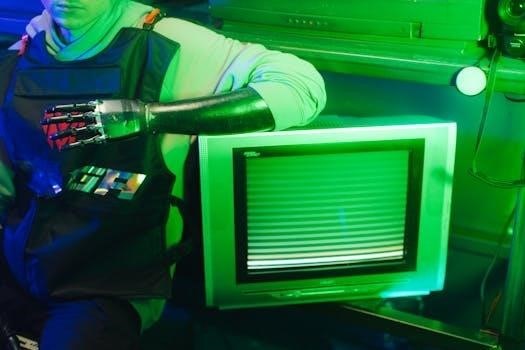modern robotics pdf

Here’s the requested content⁚
Modern Robotics⁚ Mechanics, Planning, and Control (PDF Overview)
This textbook offers a unified approach to robotics, covering mechanics, planning, and control. It bridges the gap between theory and practical applications, ideal for students seeking a comprehensive understanding. A slightly older PDF version is available online.
Here’s the requested content⁚
Unified Approach to Robotics
Modern Robotics⁚ Mechanics, Planning, and Control takes a unified approach, presenting robotics as a cohesive field rather than a collection of disparate topics. It synthesizes kinematics, dynamics, motion planning, and control into a single framework. This integrated perspective allows readers to understand how these elements interact. The textbook emphasizes core principles applicable across diverse robotic systems. By focusing on a unified framework, it aims to provide a deeper, more intuitive understanding of robotics than traditional approaches. It will help bridge the gap between theoretical knowledge and the practical application in the field of robotics.
Here’s the requested content⁚
Key Concepts Covered
The textbook Modern Robotics comprehensively covers essential concepts. Key areas include robot kinematics, focusing on robot motion and configuration. Robot dynamics, dealing with forces and torques, are also explored in detail. Motion planning algorithms are presented, enabling robots to navigate complex environments. Feedback control strategies are explained. The book also discusses force control methods for interacting with the environment. Trajectory generation, bridging the gap between planning and control, is another key topic. This thorough coverage prepares students for advanced topics and real-world applications in robotics. Each concept is explained clearly and in detail with plenty of worked out examples.
Here’s the requested content⁚
Target Audience and Prerequisites
Modern Robotics⁚ Mechanics, Planning, and Control is designed for undergraduate students and individuals seeking self-learning resources in robotics. The book assumes a foundation in freshman-level physics, ordinary differential equations, and linear algebra. A basic understanding of computing is also beneficial. The content is structured to accommodate learners with varying backgrounds. It is suitable for robotics courses and self-study. The unified approach and clear explanations make it accessible to a broad audience. This book is a valuable resource for students and professionals interested in modern robotics.
Here’s the requested content⁚
Availability of the PDF
A PDF version of “Modern Robotics⁚ Mechanics, Planning, and Control” is accessible online for free. While a digital copy is convenient, a physical copy can enhance studying and material absorption.
Here’s the requested content⁚
Free Online Access
The “Modern Robotics⁚ Mechanics, Planning, and Control” textbook offers the advantage of free online access, making it readily available to students and researchers. This accessibility allows for convenient studying and reference without the immediate need to purchase a physical copy. Online access facilitates quick searches, copying code examples, and viewing supplementary materials that might be linked within the digital version. Moreover, this open availability promotes wider dissemination of knowledge in robotics, enabling individuals from various backgrounds and institutions to engage with the core concepts of mechanics, planning, and control.
Here’s the requested content⁚
Physical Copy Benefits
While a PDF version offers accessibility, a physical copy of “Modern Robotics⁚ Mechanics, Planning, and Control” enhances the learning experience. Having a tangible book allows for focused studying without digital distractions. Annotating directly within the pages fosters deeper engagement with the material. The physical format also eliminates concerns about screen fatigue, software compatibility, or internet access; Owning a physical copy supports a more immersive and comprehensive understanding, proving more effective for long-term retention and quick reference. Furthermore, a physical book does not depend on electronic devices or power, ensuring accessibility anytime, anywhere.
Here’s the requested content⁚

Authors⁚ Lynch and Park
Kevin M. Lynch and Frank C. Park are the esteemed authors of “Modern Robotics⁚ Mechanics, Planning, and Control.” Their combined expertise offers a distinct and unified perspective on the subject. Frank C. Park had been teaching robot kinematics at Seoul National University since 1996, using his lecture notes as a base. Together, they decided to write an undergraduate textbook on robotics, culminating in this comprehensive work. Their textbook bridges theoretical foundations with practical applications, making it invaluable for students and researchers alike. Lynch also co-authored “Embedded Computing and Mechatronics with the PIC32 Microcontroller”.
Here’s the requested content⁚

Applications of Modern Robotics
Robotics is applied in rapid prototyping, 3D printing, and interactive manufacturing. Human-robot collaboration is a key area, enabling robots to work closely with humans in manufacturing and other applications.
Here’s the requested content⁚
Rapid Prototyping and 3D Printing
Modern robotics significantly impacts rapid prototyping and 3D printing. A robot-based 3D printing system integrates a six-degree-of-freedom industrial robot into fused deposition modeling. This integration offers great potential for creating prototypes quickly and efficiently. Robots enhance precision and automation in additive manufacturing processes. The ability to create complex geometries and customized parts is greatly improved. The integration allows for printing in close contact with humans, enabling new interactive manufacturing scenarios. Robotic systems offer increased flexibility and scalability for diverse printing applications, and the integration of robotics and 3D printing is revolutionizing manufacturing processes.
Here’s the requested content⁚
Interactive Manufacturing and Human-Robot Collaboration
Robotics plays a crucial role in interactive manufacturing and human-robot collaboration. Integrating robots in close proximity to humans revolutionizes manufacturing processes. This collaboration enhances efficiency, safety, and flexibility on the factory floor. Robots can handle repetitive or dangerous tasks, freeing human workers to focus on more complex and creative activities. Advanced sensors and control systems enable robots to respond dynamically to human input and adapt to changing conditions. This creates a collaborative environment where humans and robots work together seamlessly, optimizing productivity and improving the overall quality of manufactured goods.
Here’s the requested content⁚

Textbook Features
The textbook offers clear explanations and detailed examples, making complex concepts accessible. It includes supplementary materials like software and videos for enhanced learning. Practice problems and simulations are also available.
Here’s the requested content⁚
Clear Explanations and Examples
This textbook distinguishes itself through its commitment to clarity. Every concept is explained clearly and in detail with plenty of worked-out examples, ensuring accessibility for self-learning or structured courses. Assuming only freshman-level physics, ordinary differential equations, linear algebra, and a little computing background, the book carefully builds understanding. The authors, Lynch and Park, prioritize conveying intricate robotic principles in an understandable manner. This approach makes it a go-to resource for grasping the mechanics, planning, and control aspects of modern robotics. The emphasis on examples further solidifies comprehension and practical application.
Here’s the requested content⁚
Supplementary Materials (Software, Videos)
To enhance the learning experience, the textbook is accompanied by a wealth of supplementary materials. These resources include software tools designed to aid in simulations and practical exercises, allowing readers to apply the concepts discussed in the book. Furthermore, video lectures are available, providing visual explanations and demonstrations of key principles. These videos offer an alternative learning style, catering to different preferences and helping to clarify complex topics. Practice problems, errata, and even an errata reporting form are available to support self-study and ensure accuracy. These supplements enrich the learning process.
Here’s the requested content⁚

Related Resources
To further your robotics education, consider exploring online courses that delve deeper into specific topics. Other robotics textbooks are also available, offering different perspectives and approaches to the field. Consider resources about robot vision too!
Here’s the requested content⁚
Online Courses
For those seeking a structured learning experience, online courses offer a valuable supplement to the “Modern Robotics” textbook. These courses often feature video lectures, interactive simulations, and assignments to reinforce key concepts. Platforms like Coursera host courses directly related to the material, providing a guided path through kinematics, dynamics, and control. These online resources frequently include quizzes and projects that test comprehension and build practical skills. They offer flexibility and accessibility, allowing learners to study at their own pace and connect with a global community of robotics enthusiasts. Some courses may also cover advanced topics not explicitly detailed in the textbook, expanding the scope of knowledge. The online format is ideal for self-learning.
Here’s the requested content⁚
Other Robotics Textbooks
While “Modern Robotics” provides a strong foundation, exploring other robotics textbooks can broaden one’s understanding. Some books focus specifically on robot vision and sensors, complementing the mechanics-centric approach of Lynch and Park. Others delve deeper into particular areas, like robot learning or advanced control techniques. Textbooks on embedded computing and mechatronics can also be valuable, especially for those interested in the hardware aspects of robotics. Examining different perspectives and approaches helps to solidify understanding and exposes learners to a wider range of tools and techniques. Consulting multiple resources is crucial for a comprehensive education. The key is to find resources that address individual learning needs and interests within the vast field of robotics.